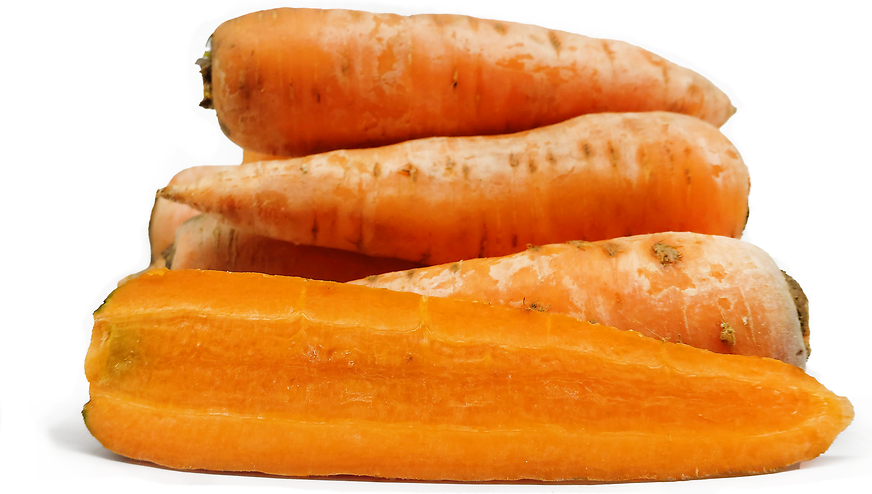


Abaco Carrots
Estimated Inventory, 1 Lb : 0
Description/Taste
Abaco carrots are a medium to large varietal, averaging 4 to 6 centimeters in diameter and 14 to 20 centimeters in length, and have a thick, conical shape tapering from flat, curved shoulders to a blunt tip on the non-stem end. The carrots have a fairly uniform appearance, and the dark orange skin is thin, semi-smooth, firm, and lightly ridged with some striations and indentations. Underneath the surface, the flesh is dense, orange, and hard, creating a crunchy, snap-like consistency. The flesh also encases a central orange core that extends the length of the root. Abaco carrots have a faint, earthy scent and a sweet, subtly vegetal flavor when consumed raw. When cooked, the flesh will mellow and develop rich, savory-sweet nuances. In addition to the roots, Abaco carrots produce semi-sprawling, feathery green tops attached by long and slender green stems. Carrot tops are edible and have a bright, grassy, and green flavor.
Seasons/Availability
Abaco carrots are available in the late summer through winter.
Current Facts
Abaco carrots, botanically classified as Daucus carota, are a hybrid variety belonging to the Apiaceae family. The large, thick carrots were created in the early 21st century as an improved modern cultivar and are valued for their size, uniform shape, coloring, and sweet, crunchy flesh. Abaco carrots are fast-growing, ready for harvest between 100 to 115 days, and produce high yields in a wide array of soils. Commercial growers and home gardeners, especially in Central Asia and Eastern Europe, choose Abaco carrots for their durability, long storage life, and resistance to disease and cracking. Abaco carrots are sold in local markets and are utilized as an everyday ingredient in raw and cooked applications.
Nutritional Value
Abaco carrots are an excellent source of beta-carotene, which is converted into vitamin A in the body to maintain healthy organ functioning. The roots also provide fiber to regulate the digestive tract, vitamin C to strengthen the immune system while reducing inflammation, vitamin K to assist in faster wound healing, potassium to balance fluid levels, and contain other amounts of folate, magnesium, iron, biotin, and calcium.
Applications
Abaco carrots have a sweet taste and crunchy, snap-like consistency well suited for raw and cooked preparations. The carrots can be consumed fresh, out-of-hand as a snack, peeled or unpeeled, depending on preference, or they can be grated into a simple side dish. Abaco carrots can also be chopped into green salads, served as an accompaniment to dips and sauces on appetizer plates, or carved as an edible garnish. In addition to raw dishes, Abaco carrots can be shredded and cooked into fritters, sautéed into rice dishes, minced into filling for dumplings, sliced and tossed into soups and stews, or roasted and served with cooked meats. The roots can also be boiled in stock, sugar, and salt and cooked with milk to create a creamed carrot dish, glazed into a savory-sweet side, or incorporated into desserts such as carrot cake. Beyond fresh preparations, Abaco carrots are commonly canned or pickled and are consumed as a preserved food during the cold winter months. Processed carrots are also sold commercially as a convenient food source. Abaco carrots pair well with herbs such as cilantro, parsley, and coriander, aromatics including onions, garlic, shallots, and chives, cayenne pepper, paprika, meats such as pork, lamb, and beef, cucumbers, apples, and beets. Whole, unpeeled Abaco carrots will keep up to one month when loosely placed in a plastic bag with good air circulation and stored in the refrigerator’s crisper drawer.
Ethnic/Cultural Info
Abaco carrots are a favored variety for preparing morkovcha, a shredded carrot dish marinated in herbs, spices, other aromatics, and vinegar. The dish was created by the Koryo-saram, a Korean people group who migrated to Russia in the mid-19th century. Not long after their migration, the Koryo-saram were forced to leave Russia in the 1930s, and they spread into Central Asia and Eastern Europe. During this time, kimchi was a staple element in the cuisine of the Koryo-saram, but when cabbage was not readily available in their new homes in Central Asia, they created a variation using carrots. Morkovcha stems from the Russian word “morkov,” meaning “carrot,” and the Koryo-mar word “cha,” meaning “banchan or small side dish.” The carrot salad is sometimes known as Russian carrot salad or Korean carrot salad, but despite its Korean moniker, the dish is mainly served in Central Asia through local vendors and home kitchens. Morkovcha can be sweet, garlicky, and mild, or it can be very spicy, depending on the amount of chile pepper used. The dish is also traditionally flavored with cilantro or coriander seeds as a refreshing element. Since its creation in the mid to late 20th century, morkovcha has been offered throughout Asia and has become a crunchy, savory, and sweet appetizer or side dish to main courses.
Geography/History
Abaco carrots were developed by Dutch breeders at Monsanto Holland B.V. in 2005. The F1 variety was created from several natural crosses and sought to improve upon a commercially popular carrot known as shantane. Abaco carrots were selected for their early-season harvest, large size, sweet flavoring, and ability to be grown in sandy or clay soils. The variety was later introduced for commercial cultivation in Central Asia and was added as a variety to the Russian State Register in 2009. Today Abaco carrots are mainly grown in Central Asia and Eastern Europe. The carrots thrive in temperate climates and can grow in various soils, making them a popular home garden cultivar. They are also produced through small farms for sale in local markets. Abaco carrots are grown in Russia, Moldova, Ukraine, Uzbekistan, and other parts of Central Asia.




